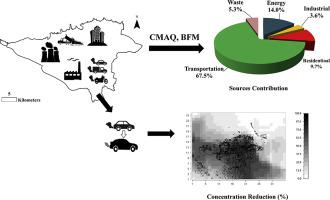Atmospheric Pollution Research ( IF 3.9 ) Pub Date : 2020-05-08 , DOI: 10.1016/j.apr.2020.05.008 Nooshin Daneshpajooh , Mohammad Arhami , Hassan Azoji

|
Tehran is one of the most polluted cities in Middle East which during winter extremely high levels of particulate matter (PM) occurs due to frequent stable weather episodes. This study aims to identify major sources of PM and quantify effectiveness of possible control measures and strategies during these episodes. The Brute Force Method (BFM) with Community Multiscale Air Quality model (CMAQ) was implemented to estimate the contributions from major local anthropogenic sources on PM levels. In this regard several scenarios including the effect of existing governmental policies and regulations to upgrade vehicles emission standards were investigated. Emission due to the existing condition and future scenarios were estimated and effect of them on concentrations were modeled. Major local contributors were found to be transportation, energy and residential sources with the contributions of 64%, 15%, and 11%, respectively. The major governmental regulation to upgrade vehicles standard could led up to average of 35% PM concentration reduction during these stable weather episode. It is estimated that a set of scenarios could result in a goal of about 10% reduction in overall pollutant emissions, including both primary PM and precursor pollutants such as sulfate, nitrate and ammonium species. Our results show primary pollutants reduction led to average 8.4% reduction in aerosol levels, whereas precursor gaseous reduction could led to less than 1% PM concentration reduction. The results emphasize the need for control strategies focusing on primary particulate emission and transportation source.
中文翻译:

德黑兰冬季稳定期间的PM散布和政府排放法规的影响
德黑兰是中东污染最严重的城市之一,由于频繁的稳定天气事件,冬季冬季颗粒物含量极高。这项研究旨在确定PM的主要来源,并量化这些发作期间可能采取的控制措施和策略的有效性。实施了带有社区多尺度空气质量模型(CMAQ)的蛮力方法(BFM),以估计当地主要人为源对PM水平的贡献。在这方面,研究了几种情景,包括现行政府政策和法规对提高车辆排放标准的影响。估算了由于现有条件和未来情景而产生的排放,并模拟了它们对浓度的影响。发现当地的主要贡献者是交通,能源和住宅能源,分别贡献了64%,15%和11%。在这些稳定的天气情况下,政府对车辆标准进行升级的主要法规可能导致平均PM浓度降低35%。据估计,一系列情景可能会导致总体污染物排放减少约10%的目标,包括主要的PM和前体污染物,例如硫酸盐,硝酸盐和铵盐。我们的结果表明,主要污染物的减少导致气溶胶水平平均降低8.4%,而前体气体的减少可能导致PM浓度降低不到1%。结果强调需要针对主要颗粒物排放和运输源的控制策略。在这些稳定的天气情况下,政府对车辆标准进行升级的主要法规可能导致PM浓度平均降低35%。据估计,一系列情景可能会导致总体污染物排放减少约10%的目标,包括主要的PM和前体污染物,例如硫酸盐,硝酸盐和铵盐。我们的结果表明,主要污染物的减少导致气溶胶水平平均降低8.4%,而前体气体的减少可能导致PM浓度降低不到1%。结果强调需要针对主要颗粒物排放和运输源的控制策略。在这些稳定的天气情况下,政府对车辆标准进行升级的主要法规可能导致平均PM浓度降低35%。据估计,一系列情景可能会导致总体污染物排放减少约10%的目标,包括主要的PM和前体污染物,例如硫酸盐,硝酸盐和铵盐。我们的结果表明,主要污染物的减少导致气溶胶水平平均降低8.4%,而前体气体的减少可能导致PM浓度降低不到1%。结果强调需要针对主要颗粒物排放和运输源的控制策略。据估计,一系列情景可能会导致总体污染物排放减少约10%的目标,包括主要的PM和前体污染物,例如硫酸盐,硝酸盐和铵盐。我们的结果表明,主要污染物的减少导致气溶胶水平平均降低8.4%,而前体气体的减少可能导致PM浓度降低不到1%。结果强调需要针对主要颗粒物排放和运输源的控制策略。据估计,一系列情景可能会导致总体污染物排放减少约10%的目标,包括主要的PM和前体污染物,例如硫酸盐,硝酸盐和铵盐。我们的结果表明,主要污染物的减少导致气溶胶水平平均降低8.4%,而前体气体的减少可能导致PM浓度降低不到1%。结果强调需要针对主要颗粒物排放和运输源的控制策略。而前体气体的还原可能导致PM浓度降低不到1%。结果强调需要针对主要颗粒物排放和运输源的控制策略。而前体气态还原可能导致PM浓度降低不到1%。结果强调需要针对主要颗粒物排放和运输源的控制策略。











































 京公网安备 11010802027423号
京公网安备 11010802027423号